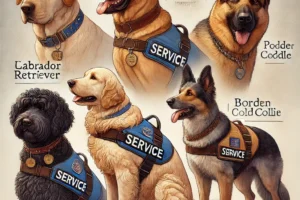Dogs often exhibit excitement when encountering strangers due to a combination of instinct, socialization, and their inherently sociable nature. Dogs are pack animals with a strong sense of loyalty and territorial instincts. When they encounter new individuals, their curiosity is piqued, and they may perceive the stranger as a potential member of their pack or someone who could pose a threat. Additionally, dogs are highly social creatures that thrive on interaction and new stimuli. Meeting new people provides an opportunity for social engagement, sniffing, and exploring, all of which are integral to their sensory experience. Positive past experiences with strangers during early socialization can further reinforce this excitement. Moreover, dogs are adept at reading human body language and emotions, and they may mirror the positive energy and enthusiasm of a friendly stranger. In essence, a dog’s excitement towards strangers can be attributed to a combination of their natural instincts, social nature, and past experiences that shape their perception of new individuals.
Strategies to Reduce Tension in Dogs: A Comprehensive Guide
Dogs, as sensitive and perceptive animals, can experience tension for various reasons, ranging from environmental stressors to changes in routine. Addressing and reducing tension in dogs is crucial for their overall well-being and maintaining a harmonious relationship with their human companions. In this article, we will explore practical strategies to alleviate tension in dogs and promote a calmer and happier canine companion.
Regular Exercise:
One of the most effective ways to reduce tension in dogs is through regular exercise. Physical activity not only helps to burn off excess energy but also promotes mental stimulation. Daily walks, playtime, and interactive activities engage both the body and mind, preventing the accumulation of stress.
Create a Safe Haven:
Establishing a comfortable and secure space for your dog can significantly reduce tension. Provide a designated area with a cozy bed or crate where your dog can retreat when feeling stressed. This space should be quiet, away from household commotion, and equipped with familiar toys and comforting items.
Consistent Routine:
Dogs thrive on routine, and sudden changes can cause stress. Maintain a consistent daily schedule for feeding, walks, playtime, and bedtime. Predictability fosters a sense of security, helping to reduce anxiety and tension in your dog.
Positive Reinforcement Training:
Training techniques based on positive reinforcement can contribute to a dog’s overall well-being. Rewarding desired behaviors with treats or praise reinforces positive associations and helps build a strong bond between you and your pet. This positive interaction can alleviate tension and create a positive atmosphere.
Calming Supplements and Products:
Consider natural calming supplements or products designed to reduce stress in dogs. Options like calming collars, pheromone diffusers, and herbal supplements can have a calming effect on your pet. Consult with your veterinarian to explore suitable options based on your dog’s specific needs.
Socialization:
Proper socialization is vital for dogs to feel comfortable in various environments and around different people and animals. Gradual exposure to new experiences can help desensitize them to potential stressors, reducing tension in unfamiliar situations.
Mind Games and Puzzle Toys:
Mental stimulation is as important as physical exercise. Engage your dog’s mind with puzzle toys, interactive games, and obedience training. These activities not only provide intellectual challenges but also divert their focus from potential stress triggers.
Regular Veterinary Check-ups:
Health issues can contribute to behavioral changes and tension in dogs. Ensure your dog receives regular veterinary check-ups to rule out any underlying medical concerns that may be affecting their behavior.
Reducing tension in dogs requires a holistic approach that combines physical and mental stimulation, consistent routines, positive reinforcement, and a supportive environment. By understanding your dog’s needs and employing these strategies, you can create a conducive atmosphere for a happy, relaxed, and well-adjusted canine companion. Always consult with a professional, such as a veterinarian or dog behaviorist, for personalized advice based on your dog’s individual characteristics and circumstances.






